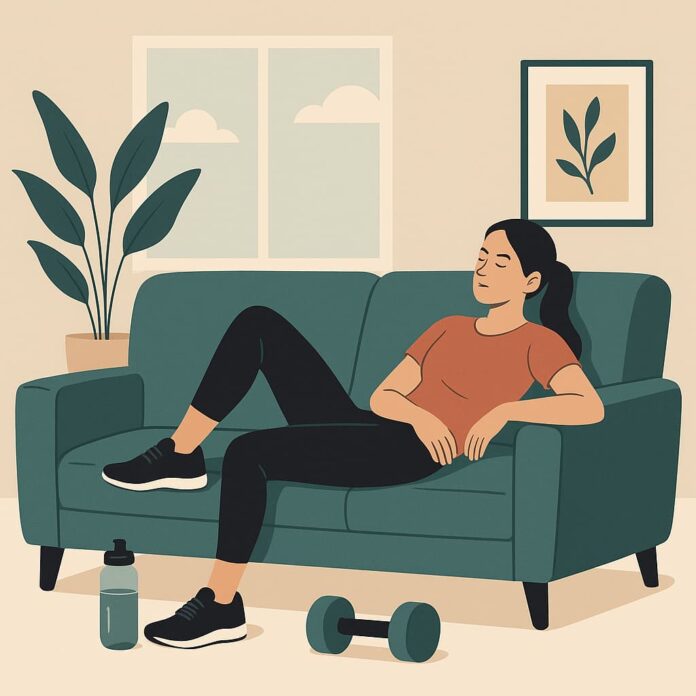In today’s productivity-obsessed world, rest is often mistaken for weakness. But in truth, rest is one of the most powerful tools for growth, health, and longevity.
A proper rest day doesn’t just allow muscles to heal — it refreshes your mind, resets motivation, and strengthens performance. Whether you’re a fitness enthusiast or a busy professional, learning how to rest strategically can transform your energy, focus, and resilience.
Introduction
Rest days are not a sign of weakness but a key part of progress. They allow your body to repair muscles, restore energy, and reset your mind after continuous activity. Without proper rest, performance drops and injuries rise. A structured rest day, combining active recovery and mindful relaxation, enhances strength, focus, and overall wellbeing. It’s the balance between effort and recovery that creates sustainable growth — physically, mentally, and emotionally — for anyone pursuing lasting fitness and productivity.
1. Understanding the Real Meaning of Rest
A rest day is more than a day off. It’s a carefully planned pause that allows your body and brain to recover from physical and mental strain.
Why Rest Is Essential
- Muscle repair: Exercise creates tiny tears in muscle fibres; rest rebuilds them stronger.
- Hormonal balance: Rest lowers cortisol (stress hormone) and boosts growth hormone.
- Mental clarity: Recovery improves focus, memory, and mood regulation.
- Prevents burnout: Continuous training or work leads to fatigue, anxiety, and reduced productivity.
Taking time to rest is not slowing down — it’s setting up for long-term progress.
2. The Science Behind Recovery
When you stop pushing and allow your body to rest, a series of biological processes start working in your favour.
What Happens Inside Your Body
- Protein synthesis increases: Muscles repair and rebuild stronger.
- Energy stores replenish: Glycogen (stored carbohydrates) refills in muscles.
- Inflammation reduces: Rest lowers tissue stress and joint inflammation.
- Sleep supports repair: Deep sleep cycles release growth hormones.
How the Brain Responds
- The nervous system resets, restoring coordination and focus.
- The glymphatic system clears out metabolic waste, improving mental sharpness.
- Neurotransmitters like dopamine and serotonin rebalance, elevating your mood.
3. Active vs. Passive Recovery
Rest doesn’t always mean complete stillness. There are two primary types of recovery:
Passive Rest
- Involves complete inactivity — ideal when your body feels deeply fatigued.
- Best for recovery after intense training or high-stress periods.
- Examples: Sleeping, reading, meditation, napping, or doing nothing physically demanding.
Active Recovery
- Focuses on light movement to boost circulation and prevent stiffness.
- Helps flush lactic acid and keeps metabolism active.
- Ideal for moderate fatigue or after light workouts.
- Examples include:
- Yoga or stretching sessions
- Swimming or cycling at a relaxed pace
- Leisurely walking or hiking
- Gentle Pilates or mobility work
4. Key Physical Benefits of Taking a Rest Day
Regular rest days are critical for physical sustainability. They deliver multiple benefits that directly enhance performance and health.
Top Benefits
- Prevents injuries: Avoids overuse and repetitive stress damage.
- Improves flexibility: Reduces muscle tightness and enhances range of motion.
- Strengthens immune system: Allows immune cells to repair microdamage.
- Boosts endurance: Fully recharged energy systems improve future performance.
- Promotes better sleep: Rest lowers stress hormones, improving sleep quality.
Without proper rest, progress stalls — no matter how hard you train.
5. The Mental and Emotional Benefits of Rest
Rest isn’t just for the body; it’s for the mind. When you give yourself permission to pause, your mental performance and emotional stability thrive.
How Rest Boosts Mental Health
- Reduces stress and anxiety: Slows down the nervous system and resets your mindset.
- Improves focus: Gives your brain time to process and organise thoughts.
- Restores motivation: Prevents mental fatigue and burnout.
- Encourages mindfulness: Activities like journaling, walking, or meditation promote calmness.
A clear mind improves not only your workouts but also your decision-making and creativity in everyday life.
6. Nutrition and Hydration on Rest Days
Your diet on rest days is as important as what you eat during training. Recovery depends heavily on nutrients.
Nutrition Tips
- Eat enough protein: Supports muscle repair and growth (chicken, eggs, lentils, tofu).
- Choose complex carbohydrates: Replenish glycogen and maintain energy (brown rice, quinoa, oats).
- Add healthy fats: Improve hormone function (avocado, olive oil, nuts).
- Load up on antioxidants: Fight inflammation (berries, spinach, turmeric, green tea).
Hydration Tips
- Drink 2–3 litres of water throughout the day.
- Add electrolytes or coconut water if sweating heavily.
- Avoid excessive caffeine and alcohol, which dehydrate the body.
A well-nourished body recovers faster and performs better.
7. Designing the Perfect Rest Day Routine
Creating a structured rest day helps maximise its benefits.
Morning Routine
- Begin with light stretching or mobility exercises.
- Drink a glass of water with lemon to rehydrate.
- Do 5–10 minutes of deep breathing or meditation.
Afternoon Routine
- Focus on balanced meals with plenty of nutrients.
- Engage in gentle physical activity (walk, cycle, or swim).
- Spend time outdoors to get natural sunlight and boost vitamin D.
Evening Routine
- Limit screen time 1 hour before bed.
- Take a warm bath or use foam rollers to relax your muscles.
- Sleep at least 7–9 hours to allow deep recovery.
Consistency is key — turning rest into a ritual reinforces its impact.
8. Recognizing When Your Body Needs Rest
Sometimes your body sends clear signals that you need a break. Ignoring them can lead to overtraining and long-term setbacks.
Common Warning Signs
- Constant fatigue or lack of motivation
- Prolonged soreness beyond 48 hours
- Decline in performance or focus
- Restless sleep or insomnia
- Increased irritability or mood swings
If you notice two or more of these, schedule a rest or light recovery day immediately.
9. The Mind-Body Connection
Your body and mind work in harmony. Rest days strengthen that connection.
Ways Rest Supports Both
- Enhances self-awareness: You learn to recognise your limits.
- Improves emotional balance: Calmness reduces stress reactivity.
- Supports long-term consistency: You’re less likely to quit from burnout.
- Promotes creativity: Rested minds think clearer and generate fresh ideas.
True recovery isn’t just physical — it’s holistic.
10. How to Make Rest a Lifestyle Habit
Rest shouldn’t feel like an afterthought. It should be built into your daily and weekly rhythm.
Practical Strategies
- Plan at least one full rest day per week.
- Add one active recovery day between intense workouts.
- Use sleep trackers or fitness apps to monitor recovery.
- Keep a journal of energy levels, sleep, and soreness.
- Schedule recovery like you schedule workouts — make it non-negotiable.
Remember: success is about sustainability. Over time, balanced effort and rest yield greater long-term results.
FAQs
1. How often should I rest each week?
Most people benefit from one to two rest days weekly, depending on workout intensity and personal recovery rate. Rest allows your muscles, joints, and mind to recharge, reducing fatigue and injury risk. Listen to your body’s signals — if you’re sore, exhausted, or unmotivated, it’s time to pause. Consistent rest supports long-term performance, ensuring that your body adapts and grows stronger with each training cycle without the risks of overtraining or burnout.
2. What are the best active recovery activities?
Active recovery involves light, low-intensity movement that aids blood circulation without straining your body. Ideal examples include walking, swimming, yoga, or gentle cycling. These activities help flush out lactic acid, reduce stiffness, and maintain flexibility. Unlike intense workouts, they refresh your muscles while promoting relaxation and mobility. Incorporating active recovery once or twice a week prevents soreness and improves performance, making it easier to stay consistent with your overall fitness routine long-term.
3. Does sleep count as recovery?
Yes, sleep is the most vital element of recovery. During deep sleep, your body releases growth hormones, repairs muscle tissue, and consolidates learning and memory. A lack of quality sleep slows muscle recovery, increases stress, and reduces focus. Aim for 7–9 hours of restful sleep each night, maintain a regular bedtime, and limit screen time before bed. Sleep is where most physical repair and mental restoration truly happen, completing the recovery process effectively.
4. How does rest impact mental health?
Rest days refresh not only your body but also your mind. They reduce cortisol levels, improving mood and emotional stability. Mental rest enhances focus, creativity, and decision-making while lowering stress and anxiety. By stepping back from constant activity, you allow your brain to recharge, improving productivity and motivation. Integrating mindfulness practices like meditation or journaling on rest days supports emotional balance, resilience, and long-term mental wellbeing, helping you stay motivated and clear-headed every day.
5. Should I eat differently on rest days?
Yes, nutrition remains essential even on rest days, but calorie needs may be slightly lower. Focus on high-quality proteins to repair muscles, complex carbohydrates to replenish glycogen, and healthy fats for hormonal balance. Include fruits and vegetables rich in antioxidants to reduce inflammation. Avoid skipping meals or overindulging; instead, maintain balanced, nutrient-rich eating habits. Proper hydration also supports recovery by helping nutrient transport and toxin removal, ensuring your body fully benefits from the downtime.
6. How do I know if I’m overtraining?
Signs of overtraining include persistent fatigue, irritability, prolonged soreness, poor sleep, and a noticeable decline in performance. You might also experience frequent injuries or lack motivation to train. When these symptoms appear, it’s crucial to take a full rest day or two, focus on nutrition, and get adequate sleep. Overtraining can lead to burnout and muscle breakdown, so paying attention to your body’s cues ensures consistent, healthy progress and sustainable long-term results.
7. Can stretching alone be enough on a rest day?
Yes, gentle stretching or yoga can serve as excellent active recovery methods. They promote flexibility, relieve muscle tension, and enhance blood flow without overexertion. Stretching also supports better posture and mobility while calming the mind. When combined with hydration, balanced nutrition, and deep breathing, it helps your body reset efficiently. Just 20–30 minutes of slow, mindful movement can significantly boost recovery and ensure you’re ready for your next workout session.
Conclusion
Rest is not laziness — it’s strategic recovery. It transforms fatigue into strength, chaos into clarity, and effort into progress. Every great athlete, thinker, and professional understands this principle: growth requires both motion and stillness.
By combining active recovery, mindful rest, quality nutrition, and sleep, you can optimise performance while protecting your mental wellbeing. Learn to embrace rest not as a pause, but as part of the rhythm of excellence. That’s where true endurance and success begin.









